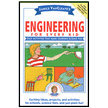 |
Janice VanCleave’s Engineering for Every Kid: Easy Activities That Make Learning About Engineering Fun
Ideas that can be developed into Engineering Projects. |
The following guidelines are set by the International Science and Engineering Fair (ISEF).
Note that these guidelines address judging of both science projects and engineering projects. This comparison gives you clues about the similarities between science and engineering.
The guidelines are from the Society for Science. For more information see their website. www.societyforscience.org
Suggested Evaluation Criteria for Judging
While judges have the latitude to determine how to establish their own score using a 100-point scale, the following is suggested as a guideline for point distribution. Points are assigned to creative ability, scientific thought or engineering goals (II a. and b. respectively), thoroughness, skill, and clarity.
Following is a list of questions for each set of criteria that can
assist you in interviewing the finalists and aid in your evaluation of the finalists’ projects. (Science and Engineering)
I. Creative Ability (Individual – 30, Team – 25)
1) Does the project show creative ability and originality in the questions asked?
a. in the approach to solving the problem?
b. in the analysis of the data?
c. in the interpretation of the data?
d. in the use of equipment?
e. in the construction or design of new equipment?
2) Creative research should support an investigation and help answer a question in an
original way.
3) A creative contribution promotes an efficient and reliable method for solving a problem.
When evaluating projects, it is important to distinguish between gadgeteering and
ingenuity.
II a. Scientific Thought (Individual – 30, Team – 25) (Science)
(If an engineering project, please see IIb. Engineering Goals.)
1) Is the problem stated clearly and unambiguously?
2) Was the problem sufficiently limited to allow plausible attack? Good scientists can
identify important problems capable of solutions.
3) Was there a procedural plan for obtaining a solution?
4) Are the variables clearly recognized and defined?
5) If controls were necessary, did the student recognize their need and were they used
correctly?
6) Are there adequate data to support the conclusions?
7) Does the finalist/team recognize the data’s limitations?
8) Does the finalist/team understand the project’s ties to related research?
9) Does the finalist/team have an idea of what further research is warranted?
10) Did the finalist/team cite scientific literature, or only popular literature (e.g, local
newspapers, magazines)?
II b. Engineering Goals (Individual – 30, Team -25)
1) Does the project have a clear objective?
2) Is the objective relevant to the potential user’s needs?
3) Is the solution: workable? acceptable to the potential user? economically feasible?
4) Could the solution be utilized successfully in design or construction of an end product?
5) Is the solution a significant improvement over previous alternatives or applications?
6) Has the solution been tested for performance under the conditions of use?
III. Thoroughness (Individual – 15, Team – 12) (Science and Engineering)
1) Was the purpose carried out to completion within the scope of the original intent?
2) How completely was the problem covered?
3) Are the conclusions based on a single experiment or replication?
4) How complete are the project notes?
5) Is the finalist/team aware of other approaches or theories?
6) How much time did the finalist or team spend on the project?
7) Is the finalist/team familiar with scientific literature in the studied field?
IV. Skill (Individual – 15, Team – 12)(Science and Engineering)
1) Does the finalist/team have the required laboratory, computation, observational and
design skills to obtain the supporting data?
2) Where was the project performed? (i.e., home, school laboratory, university
laboratory) Did the student or team receive assistance from parents, teachers, scientists
or engineers?
3) Was the project completed under adult supervision, or did the student/team work
largely alone?
4) Where did the equipment come from? Was it built independently by the finalist or
team? Was it obtained on loan? Was it part of a laboratory where the finalist /team
worked?
V. Clarity (Individual – 10, Team – 10)(Science and Engineering)
1) How clearly does the finalist or team discuss his/her/their project and explain the
purpose, procedure, and conclusions? Watch out for memorized speeches that reflect
little understanding of principles.
2) Does the written material reflect the finalist’s or team’s understanding of the research?
3) Are the important phases of the project presented in an orderly manner?
4) How clearly is the data presented?
5) How clearly are the results presented?
6) How well does the project display explain the project?
7) Was the presentation done in a forthright manner, without tricks or gadgets?
8) Did the finalist/team perform all the project work, or did someone help?
VI. Teamwork (Team Projects only- 16)(Science and Engineering)
1) Are the tasks and contributions of each team member clearly outlined?
2) Was each team member fully involved with the project, and is each member familiar with
all aspects of the project?
3) Does the final work reflect the coordinated efforts of all team members?
Total Possible Score for Individual or Team -100 points